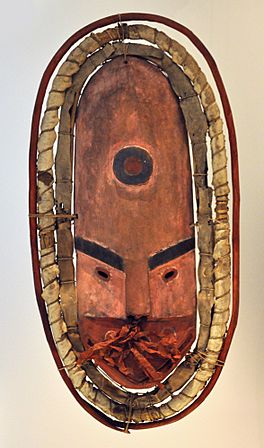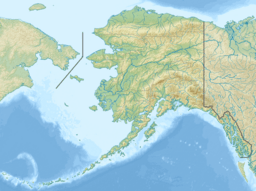Kuskokwim Bay facts for kids
Quick facts for kids Kuskokwim Bay |
|
|---|---|

Mask from Kuskokwim Bay (wood, fur, straw, feather, leaf)
|
|
| Location | Alaska, United States |
| Coordinates | 59°30′N 162°30′W / 59.500°N 162.500°W |
| Type | Bay |
| Etymology | Kuskokwim River |
| River sources | Kuskokwim River |
| Max. length | 160 kilometres (99 mi) |
| Max. width | 160 kilometres (99 mi) |
Kuskokwim Bay is a large bay located in the southwestern part of Alaska, a state in the United States. A bay is a body of water that is partly surrounded by land, usually with a wide opening to a larger body of water like an ocean. Kuskokwim Bay is about 160 kilometers (100 miles) long and 160 kilometers (100 miles) wide. It's a significant natural feature in this remote part of Alaska.
Where is Kuskokwim Bay?
This bay is found in southwestern Alaska, facing the Bering Sea. Its exact location is around 59°30′ North latitude and 162°30′ West longitude. This area is known for its vast wilderness and unique Native Alaskan cultures. The bay's waters are part of the larger Bering Sea ecosystem.
The Kuskokwim River
The Kuskokwim Bay gets its name from the Kuskokwim River, which is one of Alaska's longest rivers. This mighty river flows into the bay, bringing fresh water and nutrients from inland areas. The river's flow greatly influences the bay's environment. It also plays a big role in the lives of the people who live along its banks and near the bay.
Communities on the Bay
The largest community located directly on Kuskokwim Bay is the city of Quinhagak. This small town is home to many Yup'ik people, who are an Indigenous group of Alaska. For centuries, the Yup'ik people have relied on the bay and the Kuskokwim River for their way of life. They fish, hunt, and gather resources from the area. The bay provides important food sources like salmon and other fish.
Importance of the Bay
Kuskokwim Bay is important for several reasons. It supports a rich variety of wildlife, including many types of fish, birds, and marine mammals. The bay's waters are also crucial for local transportation and trade. Boats and barges use the bay and river to move goods and people. For the communities living there, the bay is not just a geographical feature; it's a vital part of their culture and survival.


